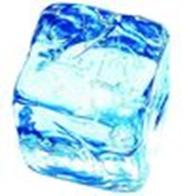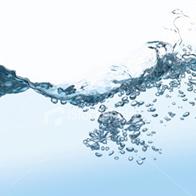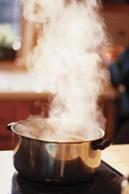Features of various methods of heat transfer. Examples of heat transfer in nature and technology
Lesson Objectives:
General education: to summarize the basic knowledge on the topic “Types of heat transfer”, to acquaint eighth graders with the manifestations of thermal conductivity, convection, radiation in nature and technology;
Developing: to continue the formation of key skills in students that are of universal importance for various kinds activities - highlighting the problem, making decisions, searching, analyzing and processing information;
Educational: to educate collectivism, a creative attitude to the task assigned.
Preparatory work
The lesson is held in the form of a defense of educational projects on the topics "Thermal conduction in nature and technology", "Convection in nature and technology", "Radiation in nature and technology". Pupils or a teacher choose a leader who forms a group on a voluntary basis. The theme of the project is determined by agreement or as a result of a lottery.
The task of each group includes a theoretical justification, an experiment, a multimedia presentation.
Students independently distribute responsibilities, search for and collect information, analyze and present it, think over the plan of the experiment, prepare the necessary equipment for its implementation, discuss and explain the observed.
In the course of work on the project, the teacher and students work closely, in particular, consultations are held at which the teacher monitors and corrects the activities of students.
Lesson design
It is necessary to prepare a screen and a multimedia projector. A slide with the name of the topic of the lesson should be projected onto the screen. Experimental equipment should be placed on a demonstration table.
Lesson Objectives:
1. Educational:
Generalize and systematize students' knowledge on the topic: "Types of heat transfer";
Be able to describe and explain such physical phenomena as heat conduction, convection and radiation;
Be able to use the acquired knowledge in everyday life.
2. Developing:
Development of auditory and visual perception;
Development of thinking, speech, memory, attention;
Search, analysis and processing of information.
3. Educational:
Education of personal qualities (accuracy, ability to work in a team, discipline);
education of cognitive interest in the subject;
contribute to the education of a comprehensively developed personality of the child.
Equipment: screen and multimedia projector, presentation; equipment prepared by each group.
During the classes.
I. Organizational stage (2 minutes.)
Purpose: to include students in learning activities, to determine the content of the lesson:
Introduction to the lesson plan.
II. Actualization of students' knowledge (35 min.)
(W.1)
Purpose: to update knowledge about the types of heat transfer, to generalize and systematize knowledge about heat transfer, convection and radiation, to apply the knowledge gained in everyday life.
(W.2)
1. From the point of view of physics, what unites the following proverbs?(on slide)
A) Do not grab the hot iron. Then the blacksmith forges tongs so as not to burn his hands.
B) Our hut of unequal heat. Warm on the stove, cold on the floor.
C) The red sun in the white light warms the black earth.
Answer: the internal energy of bodies changes as a result of heat transfer.
2. What is the difference from the point of view of the physics of the phenomena referred to in proverbs?
Answer: These proverbs speak of different ways heat transfer.
What are the different methods of heat transfer called in physics? (Types of heat transfer)
3. And now formulate the topic of our lesson.
“Types of heat transfer”
Teacher: In our lesson, we will remember everything that we studied on the topic: "Types of heat transfer." Today we will summarize, systematize and consolidate our knowledge on this topic. The acquired knowledge is applicable in everyday life.
Let's build a knowledge system, the elements of which we learned in the study of this topic. For clarity, let's imagine this in the form of a diagram. (Templates on students' desks).
Working together (filling in together).
(W.3)
1) What will be the name of the main figure, reflecting the name of the topic and scheme?
Sh. - Types of heat transfer.
U. - Let's fix this. Figure 1 - it will be the main one in the diagram; we will add text (name) to it, select the shape or text with color.
2) What changes as a result of heat transfer? What type of energy is changed by heat transfer?
Sh. - Internal energy of bodies.
U. - Types of heat transfer are associated with a change in the internal energy of bodies.
Let's fix it in figure 2.
3) What important law does the types of heat transfer associated with a change in the internal energy of bodies obey?
Sh. - The law of conservation and transformation of energy.
W. - That's right. Let's write this in figure 3. Since this is one of the most important laws of nature, we will place figure 3 above figures 1 and 2.
4,5,6) What specific types of heat transfer have we met?
Sh. - Thermal conductivity, convection, radiation.
W. - Right. We will reflect this in the diagram, and place the figures under the main one in one row, since each corresponds to an independent physical phenomenon.
The remaining columns of the summary table must be filled in throughout the lesson, listening to the performances of the groups and using the knowledge we have gained.
U. Our lesson is devoted to the protection of educational projects. We will repeat the types of heat transfer, get acquainted with the manifestations of thermal conductivity, convection, radiation in nature and technology. Three groups chose one of the types of heat transfer. The task included theory, experiment and creation of a computer presentation. Based on the results of the defense, the group must prepare a photo report. Please note that the project defense time should not exceed 5-7 minutes.
4. Protection of projects.
(W.4)
1. What type of heat transfer is mentioned in the first proverb?
(Sl.5) (thermal conductivity) .
I group
Thermal conductivity - the phenomenon of the transfer of internal energy from one part of the body to another or from one body to another with their direct contact.
Thermal conductivity is a type of heat transfer in which internal energy is transferred from particles of a more heated part of the body to particles of a less heated part.
Experiment
Demonstration of the different thermal conductivity of a silver (wooden) spoon and a stainless steel spoon after heating them in hot water.
Different substances have different thermal conductivity. Metals have good thermal conductivity. For example, copper is used in the construction of soldering irons. The thermal conductivity of steel is 10 times less than that of copper. Wood and some types of plastics have low thermal conductivity. This property is used in the manufacture of handles for heating objects, such as kettles, pots and pans.
Felt, porous brick wool, fluff, fur (due to the presence of air between their fibers) have poor thermal conductivity, so these materials, along with wood, are widely used in housing construction.
We brought various heat-insulating materials - tow, polystyrene, which are used in construction. The regulation of heat transfer is one of the main tasks of construction equipment. In those cases where heat transfer is undesirable, they try to reduce it. To do this, use thermal insulation.
A thin layer of air between the panes of the window protects our home from the cold as well as a brick wall. This means that air has poor thermal conductivity. Liquids and gases have very low thermal conductivity, but heat can also be transferred in gases and liquids.
Strange as it may seem to you, snow, especially loose snow, has very poor thermal conductivity. This explains why a relatively thin layer of snow protects winter crops from freezing.
Animal fur, due to poor thermal conductivity, protects them from cooling in winter and overheating in summer.
(W.11)2. And what kind of heat transfer is mentioned in the second proverb?
(W.12) (convection).
II group
Convection - type of heat transfer, at which energy is transferred by jets of gas and liquid.
There are two types of convection: natural and forced.
Natural convection - spontaneous cooling, heating, movement.
Forced convection - movement with a pump, agitator, etc.
Convection in liquids. Liquids and gases are heated from below, as they have poor thermal conductivity. In hot layers of liquid (gas), the density decreases, and they rise up, giving way to colder ones. There is a circulation (“movement in a circle”) of the layers.
IN solids there is no convection, since their particles do not have high mobility.
Many manifestations of convection can be found in nature and human life. Convection also finds application in engineering.
Experiment
Demonstration of burning a candle, which is partially covered with a glass cylinder without a bottom (leave free space below); the cessation of burning the candle when the glass cylinder is completely lowered.
Experiment
There are two glasses on the table hot water, one stands on ice, and on the lid of the other lies ice. Students explain in which glass the water will cool faster (convection in liquids).
And so that the boiling water cools faster, we stir with a spoon (forced convection)
Heating and cooling of residential premises is based on the phenomenon of convection. So it is advisable to place cooling devices at the top, closer to the ceiling, so that natural convection occurs. Heating devices are located below.
Breeze - occurs at the border of land and water, because. they heat up and cool down differently. Water heats up and cools down more slowly than earth (sand) by 5 times. Because of this, an area of low pressure forms over land during the day, and an area of high pressure over the sea. There is a movement of air masses from an area of high pressure to an area of low pressure, which is called the daytime breeze. At night, everything happens the other way around.
(W.19) 3. And what type of heat transfer is mentioned in the third proverb?
(DC 20) (radiation).
III group
Radiation (radiant heat transfer) - a type of heat transfer in which energy is transferred by heat rays (electromagnetic waves).
It happens all the time and everywhere. Can be carried out in full vacuum.
Radiation comes from all heated bodies (from a person, a fire, a stove, etc.)
The higher the body temperature, the stronger its thermal radiation.
Bodies not only radiate energy, but also absorb it.
Bodies with a dark surface absorb and radiate energy better than bodies with a light surface.
The sun is the source of energy on earth.
How is solar heat transferred to Earth? Indeed, in outer space there are neither solid, nor liquid, nor gaseous bodies. Consequently, outer space cannot transfer the heat of the Sun to the Earth either by conduction or by convection. The fact is that heat from the Sun to the Earth is transmitted in the same way as a signal from a radio station to a receiver - electromagnetic waves.
Many manifestations of thermal radiation can be found in nature and human life. thermal radiation also finds application in technology.
The ability of bodies to absorb radiation energy in different ways is used by man.
Plowed soil, soil with vegetation (Slide). During the day, the soil absorbs energy and is heated by radiation, but it also cools faster. Its heating and cooling is influenced by the presence of vegetation. Thus, dark plowed soil is more strongly heated by radiation, but cools faster than soil covered with vegetation.
The weather also affects the heat exchange between soil and air. On clear, cloudless nights, the soil cools strongly - the radiation from the soil freely escapes into space. On such nights in early spring, ground frosts are possible. If the weather is cloudy, then the clouds cover the Earth and play the role of a kind of screens that protect the soil from energy loss by radiation.
Demonstration of the layout of the greenhouse. One of the means of increasing the temperature of the soil area and ground air are greenhouses, which make it possible to make fuller use of solar radiation. The soil area is covered with glass frames or transparent films. Glass well transmits visible solar radiation, which, falling on dark soil, heats it up, but transmits worse invisible radiation emitted by the warm surface of the earth. Also, the film (glass) prevents the movement of warm air upwards, i.e. implementation of convection. In this way, greenhouse glass acts as a "trap" for energy. Inside the greenhouses, the temperature is higher than on unprotected soil, by about 10 ° C. (they heat the greenhouse with a lamp and measure the temperature outside and inside the greenhouse, and it turns out to be different).
Which kettle will cool the fastest?

Why are airplanes painted with silver paint, and why is the shower in the country dark?
(Dp. 26)Thermos (structure)
- How to save energy?(explain the principle of operation and the device of a thermos, focusing on the types of heat transfer.)
Cork (Fix convection)
Vacuum (Down with thermal conductivity)
Mirror (Away with radiation)
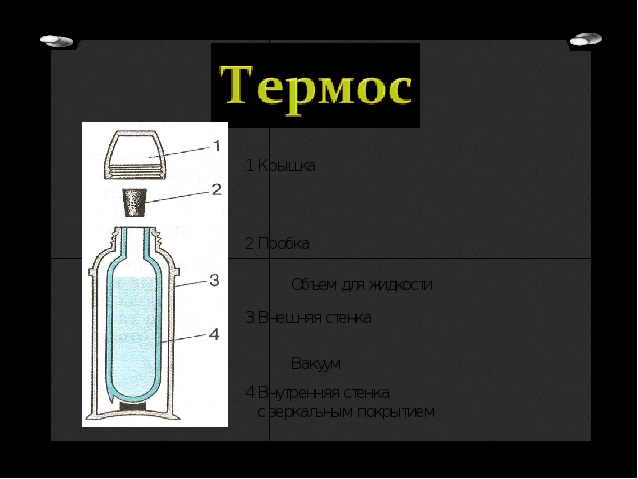
(W.27)
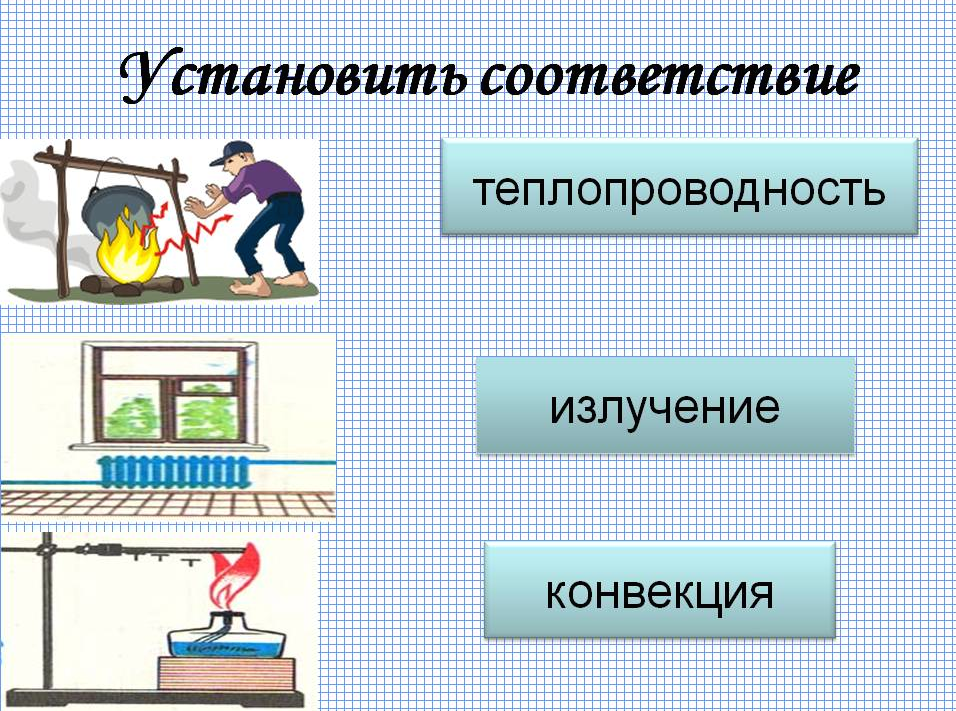
5. Discussion of the results of filling in the table
III. Conclusion (3 min)
Summarizing the results of all stages of work.
Reflection of students.
IV At home:
repeat § 3 - 6, continue filling out the table. Houses,
creative task: make crosswords on the topic "Types of heat transfer."
Students who wish can prepare reports on the application of heat transfer in nature and technology for the next lesson. Approximate topics of reports can be: “The importance of types of heat transfer in aviation and during space flights”, “Types of heat transfer in everyday life”, “Heat transfer in the atmosphere”, “Accounting and use of types of heat transfer in agriculture”, etc.
Reflection
If you understand the material, you can tell and explain it, then give yourself a “5”.
If the material is understood, but there is some doubt that you will be able to reproduce it, then “4”.
If the material is poorly mastered, then “3”.
Raise the smileys. How did we end the lesson?

Lesson reflection .
Students are asked to fill in the reflection sheets.
today I found out...
it was interesting…
I purchased...
surprised me...
gave me a lesson for life...
I wanted ... and I
Summing up the lesson, putting marks.
or
III. FINAL STAGE (3 min)
Purpose: to analyze and evaluate the success of achieving the goal and outline the prospects for further work;; thank classmates who helped to get the results of the lesson.
>>Physics: Examples of heat transfer in nature and technology
1. Winds. All winds in the atmosphere are convection currents on a huge scale. Convection, for example, explains breezes- night and day winds arising on the shores of the seas and large lakes.
On summer days, the sun warms up the land faster than the water, so the air over the land heats up more than over the water. At the same time, the air over land expands, after which its pressure becomes less than the pressure of colder air over the sea. As a result, as in communicating vessels, cold air from the bottom of the sea (where the pressure is greater) moves to the shore (where the pressure is less) - the wind blows. This is the daytime (or sea) breeze.
At night, water cools more slowly than land, and over land the air becomes colder than over water. Now over high pressure is above the land, and therefore the air begins to move from the coast to the sea. This is a night (or coastal) breeze.
2. thrust. We know that without an influx of fresh air, fuel combustion is impossible. If air does not enter the furnace or furnace, the combustion will stop. To maintain combustion, a natural influx of air is often used - draft. At the same time, a pipe is installed above the place of combustion of the fuel. When heated, the air expands, and the pressure in the furnace and pipe becomes less than the pressure of the outside air. Due to the pressure difference, cold air rushes from the outside into the furnace, and warm air rises up the pipe. This is what traction is.
With an increase in the height of the pipe, the draft increases, since the higher the pipe built above the furnace, the greater the difference in pressure between the outside air and the air in the pipe.
3. Water heating. Residents of countries located in the temperate and cold zones of the Earth are forced to heat their homes in cold weather. In residential premises, the most favorable temperature for a person is considered to be 18-20 ° C. To maintain this temperature in many homes, water heating is used.
Heating of water in central heating systems takes place outside the heated premises (in boiler houses or combined heat and power plants - CHP). From the heater, hot water flows through pipelines to the buildings. Here (Fig. 71) it rises up the main riser 1, and from there - through the pipes to the heating devices (radiators 2). As they cool down, the water returns to the bottom and again flows to the heater. This ensures continuous circulation of water throughout the system. In small buildings, this circulation occurs due to natural convection, and in large city houses it occurs due to the action of special pumps (artificial or forced convection).
To prevent the destruction of the heating system (as a result of an increase in pressure during the expansion of the heated liquid), the main riser 1 is supplied with an expansion tank 3.
4. Thermos. Heat transfer from a hotter body to a colder one leads to the equalization of their temperatures. Therefore, for example, a hot kettle removed from the stove cools down after some time when it comes into contact with the surrounding air. In order to allow a body to cool down (or heat up), it is necessary to prevent possible heat transfer, and in all its three manifestations (during convection, heat conduction and radiation). This is achieved by placing the body in a special vessel - dewar vessel, which was invented in 1892 by the English scientist James Dewar.
Dewar vessels were originally used only for storing liquefied gases that easily evaporate (for example, liquid helium). Subsequently, they began to be used for domestic purposes - to preserve food products placed in them at a constant temperature. Such Dewar vessels became known as thermoses(Fig. 72).
The device of a thermos designed for storing liquids is shown in Figure 73. It consists of a glass vessel 4 with double walls. The inner surface of these walls is covered with a shiny metal layer, and air is pumped out of the space between the walls. To protect the glass case of the thermos from damage, it is placed in a cardboard or metal case 3. The vessel is sealed with a stopper 2, and a cap 1 is screwed on top of the case. 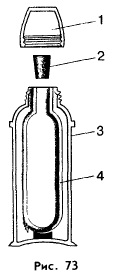
The thermos is designed in such a way that the heat exchange of its contents with environment reduced to a minimum. The absence of air between its walls prevents the transfer of energy by convection and heat conduction, and the shiny layer on the inner surface of the thermos prevents the transfer of energy by radiation.
??? 1. Why does the daytime breeze blow from the sea towards the coast, and the night breeze blows from the coast towards the sea? 2. What causes cravings? 3. How is the water heating system arranged? 4. Tell us about the thermos device. Due to what in it it is possible to reduce heat transfer? Why does food in a thermos still get cold?
S.V. Gromov, N.A. Motherland, Physics Grade 8
Submitted by readers from Internet sites
Physics planning, textbooks and books in physics grade 8, courses and assignments in physics for grade 8, abstracts of physics grade 8
Lesson content lesson summary support frame lesson presentation accelerative methods interactive technologies Practice tasks and exercises self-examination workshops, trainings, cases, quests homework discussion questions rhetorical questions from students Illustrations audio, video clips and multimedia photographs, pictures graphics, tables, schemes humor, anecdotes, jokes, comics parables, sayings, crossword puzzles, quotes Add-ons abstracts articles chips for inquisitive cheat sheets textbooks basic and additional glossary of terms other Improving textbooks and lessonscorrecting errors in the textbook updating a fragment in the textbook elements of innovation in the lesson replacing obsolete knowledge with new ones Only for teachers perfect lessons calendar plan for a year guidelines discussion programs Integrated LessonsLesson objective: Review previously learned material; to form the ability to tell a story, to express the means of thought in the correct "physical" language; to develop the horizons of students in clarifying the value of physics in human life and society; find ways to solve problems related to life situations.
During the classes.
Before the lesson, students are divided into 6 groups in accordance with these editions:
magazine "Garden and vegetable garden"
magazine "Modeler-constructor"
"Literary newspaper"
magazine "Yunnaty"
magazine "Architect"
magazine "Worker"
Imagine one day of editorial work. You have to answer questions from readers or urgently get ready for a business trip ... Everything must be resolved quickly and almost immediately. To do this, you should choose the editor-in-chief, solve the proposed questions and difficulties, submit a report on the work done (answers of the group members). The manager of the department should evaluate the work of each member of the group, and the group - the work of the manager. And now we will choose a ticket and immediately without preparation, we will answer.
What exactly is internal energy?
Give examples of ways to change internal energy.
Give examples of heat transfer patterns.
What is thermal conductivity? How does energy transfer through iron wire?
What is convection?
How is energy transferred from the Sun to the Earth? Define this type of heat transfer.
After the answers, each group is given tasks (time 5 - 7 minutes).
In equatorial lands, where the climate is hot, the skin color of people is blacker than that of those living in a cold climate. Why? Snow-white bears live in northern latitudes, and brown bears live in southern latitudes. Why? In the north lives a free-rider hare ( White color wool), in the more southern regions - stowaway hare (gray wool). Why? (Answer: black bodies exude more than white bodies, under the same conditions).
What role does the seasonal change in the length and density of wool in animals play: in summer the wool is shorter and looser, and in winter it is longer and thicker? (Answer: wool, fluff, wineskin and others porous bodies in the spaces between the fibers contain air and therefore have poor thermal conductivity, they protect the body of animals from freezing).
Cold is not an aunt.
Just like hunger, frost is not an aunt. A crow sitting on a pole will definitely sting where the frosty wind blows from. She always faces him with her beak - for example, so that the wind flows around, and does not stir up feathers. In quiet, but frosty weather, birds “fluff up” their featherbeds, turn into loose balls ... The fur keeps warm reliably. It is renewed in many animals by winter ... Frost stimulates the growth of fur. I know this from a donkey brought to the Moscow region from Central Asia. In the first winter, they sewed something like a vest out of an old sheepskin for him. And now, by winter, the donkey becomes like a fluffy monster - relatives from warm lands would not immediately recognize him.
V. Peskov.
From a Russian fairy tale: “There is no one to build a black grouse in the winter cold house, but he himself does not know how. One night of everything must be experienced ... "Oh," he thought, "no matter what!" And - plop in the snow! In the snow and spent the night. Nothing! It was warm. I got up early in the morning, flew where I needed to in the free light. What saved the black grouse from frost while spending the night in the forest?
Do not plant gardens in the lowlands. From what? (Answer: cold air is denser, so it accumulates at the bottom; frost is more common in low places).
Do not allow plants to become covered with an ice crust. Why? (Answer: the thermal conductivity of ice is 20 one more than that of snow, so plants freeze out).
Loosen the base before freezing. Why? (Answer: when loosening, the thermal conductivity of the soil decreases).
In the spring, when the likelihood of frost is very likely, memorize and repeat the poems of the Russian writer I. A. Bunin “Cold Spring”.
The colorless west is clear - expect cold by midnight.
And the nightingales sing from their warm nests all night
In dope blue smoky manure,
In the silver dust of the hazy brightest stars.
Why is there such a combination of phenomena? (Answer: with a bright sky, the earth is greatly cooled due to radiation).
Comment on excerpts from works of art from the point of view of physics.
From the fairy tale by V. Gauf “About the far-fetched prince”. “No one dared to say that Labakan was inept with the needle, on the contrary: he knew how to do very delicate work ... He often sewed without stopping, so that the needle in his hand became hot and the thread began to smoke, and the work came out better than anyone…"
From the Russian fairy tale "Wintering of animals". “The goose and the cockerel came to the bull in the barn, they say in chorus: “Let the brother go, warm yourself!” The bull replies: “No, I won’t let you in! You have two wings, you will lay one, you will dress with the other, for example, you will spend the winter! “You won’t let me in,” says the goose, “for example, I’ll pluck all the moss from your walls, but you will undoubtedly be colder!” “Don’t let go,” says the rooster. “So I’ll fly up to the attic and rake all the earth from the ceiling, it will be colder for you.”
From the Russian fairy tale "Sister Fox and the Wolf". “The wolf went to the river, lowered his tail into the hole and began to say: “Catch, fish, both small and big! Catch, fish, both small and large! Following him, the fox appeared; walks near the wolf and laments: “Clear, clear the starry sky in the sky! Freeze, freeze wolf tail! Tail and frozen."
Which house is warmer - wooden or brick? (Answer: in wood, because wood has a lower thermal conductivity).
Why builders use porous materials - porous bricks. felt, glass wool
Why are double frames made?
Why are radiators in rooms located below?
Modeler-Constructor magazine invites readers to take a role in creating space rocket which uses liquid hydrogen as fuel. Where is it stored though? The boiling point of hydrogen is -2530 C. Keeping 3 in an ordinary tank is like putting a pot of water into a blast furnace! The tank must be such that heat does not penetrate into it from the outside. As a result of the reasoning, the group comes to the conclusion that this tank should be a thermos. Explain how a thermos works. Is it possible to keep hot tea in this vessel?
Members of the editorial board of the magazine "Worker" shines to go on business trips.
The group goes to the far North and takes warm coats and hats with them. Physicists say that the expression "a fur coat warms" is incorrect. And what do you think?
This group goes south to the sea. What kind of clothes - light or dark - should they take? Why do sailors prefer to go to sea at night?
After discussing all the questions, fill in the table.
|
Name of heat transfer reception |
How energy is transferred |
Peculiarities various ways heat transfer. Examples of heat transfer in nature and technology
thermal phenomena
With the help of this lesson, you will get acquainted with the topic “Features of various methods of heat transfer. Examples of heat transfer in nature and technology. Here we summarize our knowledge of heat transfer and its existing types and consider examples of various thermal processes in physical experiments and in nature.
Today's lesson is the final one in the topic "Different methods of heat transfer", so we will make it general and discuss various methods of heat transfer in nature and technology and their features using specific examples.
It is important to understand that heat transfer processes in nature occur continuously, and we can observe them everywhere in the world around us, which we will talk about today. Consider the methods of heat transfer:
Example 1Obtaining steam from ice when heated. Let us place ice in a saucepan at a temperature below 0°C and begin to heat it, write down the processes occurring in this case and indicate the most actively manifesting methods of heat transfer at each stage of heating. Of course, we understand that the sequence of transitions of the aggregate states of matter in this case will look like in Figure 1, but we will describe them in more detail.
|
|
|
|
Rice. 1
1. Heating ice to a melting point of 0°C. The main role is played by the phenomenon of thermal conductivity, since ice is a solid body.
2. Melting of ice at 0°C, the temperature does not change until all the ice has melted. The main role is played, as before, by the phenomenon of heat conduction.
3. Heating water formed from ice from 0°C to . In this process and in all subsequent ones, the main role is already played by convection, as more effective method heat transfer in liquids and gases.
4. Boiling water and the formation of steam at. The temperature during this process also does not change. In the process of boiling, the phenomenon of convection, perhaps, manifests itself in the most striking way, since even with the naked eye one can observe the processes of constant natural mixing of boiling water.
5. Steam heating from temperature and above.
Example 2The formation of granular spots on the surface of the Sun. If you look at photographs of the Sun's surface, you can see that its entire surface is grainy, not uniform (see Fig. 2). What is it connected with?
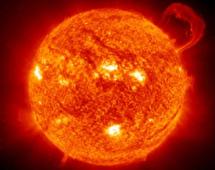
Rice. 2. The grainy surface of the Sun
The structure of the Sun can be divided into several so-called layers, one of which is located near the surface and is called the convective zone (see Fig. 3).
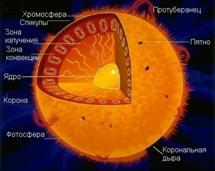
Rice. 3. Structure of the Sun
By the name of this layer, one can already guess that a convection process takes place in it: on the one hand, the substance of the photosphere, cooling on the surface, plunges deep into the convective zone, on the other hand, the substance in the lower part receives radiation from the ray transfer zone and rises up. The peaks of convective flows are irregularities on the surface of the Sun, which we can see in the photographs in the form of granularity.
Thus, it is possible to draw some analogy between the processes of a cosmic scale and the ordinary boiling of water in a saucepan.
Example 3The process of wind formation. Schematically, the process of wind formation, i.e., the movement of air masses, can be depicted in Figure 4.
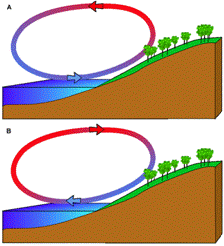
Rice. 4. The process of wind formation.
Wind currents are generated, as a rule, near water bodies, and, first of all, this phenomenon is associated with different thermal conductivity water and land (land). Wind formation is a two-part cycle:
1. During the day, the water heats up slowly, and the land receives heat faster, i.e. the air over water is colder, its density and pressure are higher than over land, and the wind begins to blow towards the land due to the resulting pressure difference.
2. At night, when the land, due to the same difference in the properties of thermal conductivity, cools faster than water, the wind begins to blow in reverse side- from land to water.
Example 4The phenomenon of draft in the chimney.
Definition.Thrust - it is a natural flow of air.
The concept of draft is encountered mainly when considering the design and principle of operation of the chimney (see Fig. 5).
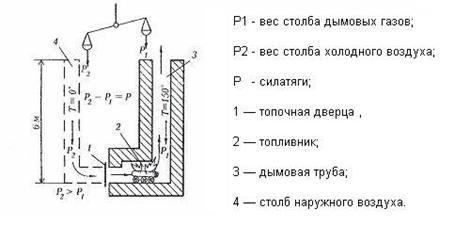
Rice. 5. The design of the chimney. Thrust pattern
The most important element of the furnace is the chimney (3), it is it that provides the movement of convective flows, which create traction. In the area of the furnace (2), a flame burns and heats up the air, whose density decreases, and, according to the law of Archimedes, it begins to rush up the pipe. The area from which the heated air began to move upwards must be filled with cold air, which enters from the outside of the furnace through the furnace door (1). Thus, the process of convective air circulation - the outflow of warm air from the pipe and the influx of cold air from the room - forms draft.
It is interesting to note that the thrust force depends on many parameters of the furnace design, but most strongly on the length and material of the pipe. For example, if an iron pipe is used, as in Figure 6, then the draft will not be so strong, because the air will have time to give up its heat to the pipe during the ascent, cool down, and the convective flow will slow down. In a brick pipe (see Fig. 7), the thermal conductivity of which is much less than iron, the air will practically not have time to cool down, and the speed of the convective flow will not fall, i.e., the draft will be stronger.
As can be seen from the above remark regarding the material of the pipe, not only the phenomenon of convection, but also thermal conductivity is important for the process of draft formation.
Example 5Features of the design of the thermos. As many people know, a thermos is a vessel that does not allow the contents to cool or heat up. There are a lot of types of thermoses: some are designed to contain liquids (hot tea or coffee), others to carry hot food, others, the so-called thermal bags, are often used to transport chilled drinks (see Fig. 8), etc.
Rice. 8. Different types of thermoses
The question arises, how is the thermos arranged, that it provides thermal insulation from the environment of those products that are in it. Interestingly, the design of the thermos involves limiting the activity of all heat transfer processes that can occur between its contents and the environment. For convenience, we depict an approximate design of a thermos in Figure 9.
One of the main parts of a thermos is a glass flask (sometimes iron), which has a double structure (a flask in a flask), and air is pumped out between its walls until a sufficiently strong vacuum is created. This design of the flask makes it possible to almost completely protect its contents from heat exchange with the environment by means of heat conduction, since there is almost no substance in vacuum, which makes it impossible for these heat exchange processes to occur effectively.
For an even greater effect of thermal insulation, the design of the flask in a thermos provides for limiting the process of heat loss by radiation. To do this, the inner surface of the bulb is covered with a thin layer of tin (rarely silver), which makes it mirror-like and prevents radiation from leaving the interior of the bulb.
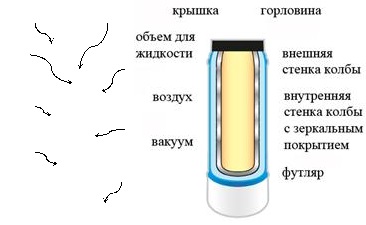
Rice. 9. The design of the thermos
Additional insulation from thermal conductivity is provided by the material of the case (housing), which primarily has a protective function and does not allow the flask to break, and an air layer between the case and the outer wall of the flask, which has rather poor thermal conductivity properties.
The main vulnerable place for heat leakage in a thermos is its neck, so the design of its lid is given special attention. The lid of a thermos usually consists of a rubber stopper that fits snugly against the neck when closed, and a porous material located inside its body, which provides additional thermal insulation.
In the examples given, we have examined the manifestation of various methods of heat transfer in nature, as well as the application and even ways to deal with them in technology. In the next lesson, we will introduce a concept with which we will further measure the volume of thermal energy - the amount of heat.
1. L. E. Gendenshtein, A. B. Kaidalov, and V. B. Kozhevnikov, Ed. Orlova V. A., Roizena I. I. Physics 8. - M .: Mnemosyne.
2. Peryshkin A. V. Physics 8. - M .: Bustard, 2010.
3. Fadeeva A. A., Zasov A. V., Kiselev D. F. Physics 8. - M .: Education.
1. Open class. Network educational societies ().
2. Cool physics for the curious ().
1. Gas holders - tanks for storing heating gas - are painted silver. Why?
2. What types of heat transfer are minimized in modern window systems?
3. Recently, the so-called "thermal bag" has gained popularity (see Fig. 10). Inside, it is covered with a material similar to metal foil, polyurethane foam is inserted between the “foil” and the outer fabric, and the top of the bag is tightly covered with a lid. What types of heat transfer in such bags are minimized?
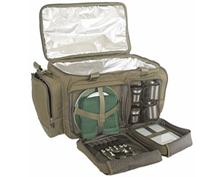
Rice. 10. Thermal bag
4. The air is transparent, it does not absorb the sun's rays, so it cannot be heated directly by them. Why is the air hot enough on a hot summer day?
COMMITTEE ON PUBLIC EDUCATION
ADMINISTRATION OF THE SOLNECHNOGORSK MUNICIPAL DISTRICT
MUNICIPAL EDUCATIONAL INSTITUTION
SECONDARY EDUCATIONAL SCHOOL № 2, SOLNECHNOGORSK
(MOU secondary school No. 2 of Solnechnogorsk)
RUSSIA 141503 Moscow region, Solnechnogorsk, Obukhovsky passage, 2a
Tel./fax 994-11-13 E-mail: [email protected]
Methodical development
physics lesson (grade 8)
"Types of heat transfer
in nature and technology »
Physics teacher
Barskaya Antonina Timofeevna
Solnechnogorsk
Methodical development of a physics lesson in the 8th grade "Types of heat transfer in nature and technology"
Lesson Objectives:
general education: to summarize the basic knowledge on the topic “Types of heat transfer”, to acquaint eighth graders with the manifestations of thermal conductivity, convection, radiation in nature and technology;
developing: to continue the formation of students' key skills that are of universal importance for various types of activities - identifying a problem, making a decision, searching, analyzing and processing information;
educational: to cultivate collectivism, a creative attitude to the task assigned.
Preparatory work
The lesson is held in the form of a defense of educational projects on the topics "Thermal conduction in nature and technology", "Convection in nature and technology", "Radiation in nature and technology". Pupils or a teacher choose a leader who forms a group on a voluntary basis. The theme of the project is determined by agreement or as a result of a lottery.
The task of each group includes a theoretical justification, an experiment, a multimedia presentation, a newspaper issue, a photo report.
Eighth graders independently distribute responsibilities, search for and collect information, analyze and present it, think over the plan of the experiment, prepare the necessary equipment for its implementation, discuss and explain the observed.
In the course of work on the project, the teacher and students work closely, in particular, consultations are held at which the teacher monitors and corrects the activities of students.
Lesson design
It is necessary to prepare a screen and a multimedia projector. A slide with the name of the topic of the lesson should be projected onto the screen. Experimental equipment should be placed on a demonstration table. Newspapers devoted to the types of heat transfer can be hung out before the lesson in the recreation area in front of the physics classroom.
During the classes
I. Introductory speech of the teacher
Hello! Our lesson is devoted to the protection of educational projects .
We will repeat the types of heat transfer, get acquainted with the manifestations of thermal conductivity, convection, radiation in nature and technology.
Three groups chose one of the types of heat transfer. The task included theory, experiment, publication of a newspaper and creation of a computer presentation. Based on the results of the defense, the group must prepare a photo report. Please note that the project protection time should not exceed 10 minutes.
Please write down the topic of the lesson in your notebooks and transfer the columns of the summary table, which must be filled in while listening to the presentations of the groups.
|
Type of heat transfer |
What carries energy? |
In what environment does it take place? |
Examples in nature and technology |
II. Project protection.
Thermal conductivity - a type of heat transfer in which energy is transferred from one body to another upon contact or from one part of it to another.
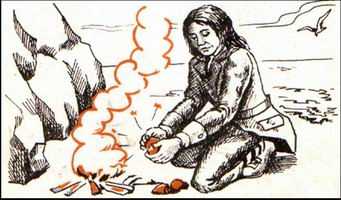
Thermal conductivity- a type of heat transfer in which there is a transfer of internal energy from particles of a more heated part of the body to particles of a less heated part.
Different substances have different thermal conductivity. Metals have good thermal conductivity. For example, copper is used in the construction of soldering irons. The thermal conductivity of steel is 10 times less than that of copper. Wood and some types of plastics have low thermal conductivity. This property is used in the manufacture of handles for heating objects, such as kettles, pots and pans.
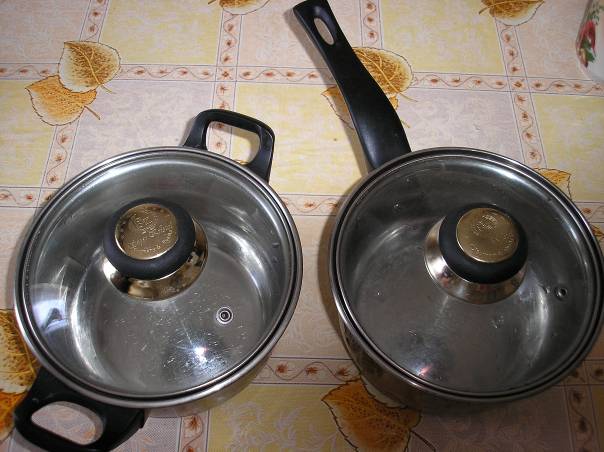
Felt, porous brick wool, fluff, fur (due to the presence of air between their fibers) have poor thermal conductivity, so these materials, along with wood, are widely used in housing construction.
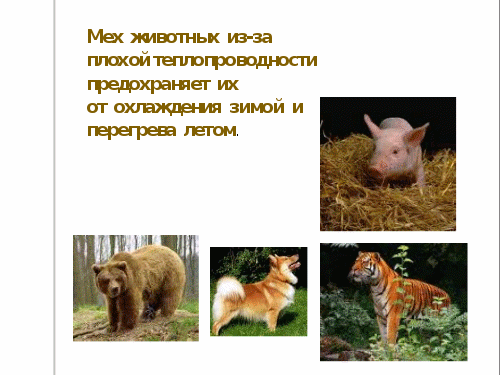
Strange as it may seem to you, snow, especially loose snow, has very poor thermal conductivity. This explains why a relatively thin layer of snow protects winter crops from freezing.
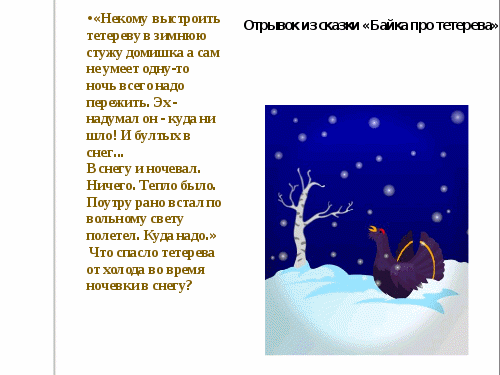
A thin layer of air between the panes of the window protects our home from the cold as well as a brick wall. This suggests that air has poor thermal conductivity. Liquids and gases have very low thermal conductivity, but heat can also be transferred in gases and liquids.
Experiment
Demonstration of the different thermal conductivity of a silver spoon and a stainless steel spoon after heating them in hot water.
Presentation"Thermal conduction in nature and technology". Student project.
Convection - a type of heat transfer in which energy is transferred by jets of gas and liquid.
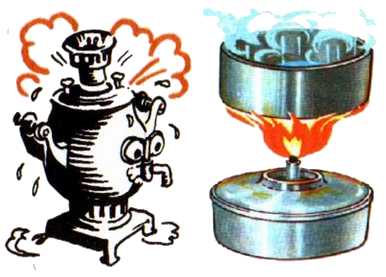
There are two types of convection: natural and forced.
![]()
Natural convection - spontaneous cooling, heating, movement.
Forced convection - movement with a pump, agitator, etc.
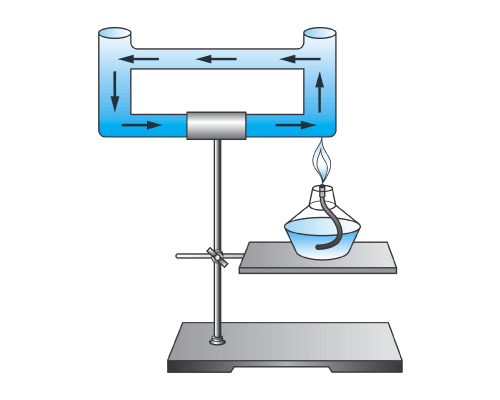
Convection in liquids. Liquids and gases are heated from below, as they have poor thermal conductivity. In hot layers of liquid (gas), the density decreases, and they rise up, giving way to colder ones. There is a circulation (“movement in a circle”) of the layers.
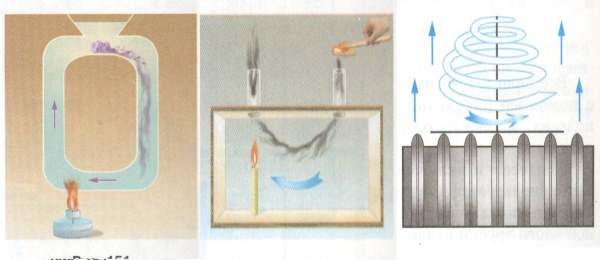
Convection is taken into account when installing heaters: batteries are located near the floor. In this case, a stable convection air movement is established in the room.
There is no convection in solids, since their particles do not have high mobility. Many manifestations of convection can be found in nature and human life. Convection also finds application in engineering.
Experiment
Demonstration of burning a candle, which is partially covered with a glass cylinder without a bottom (leave free space below); the cessation of burning the candle when the glass cylinder is completely lowered.
Presentation."Convection in nature and technology".
Radiation is a type of heat transfer in which energy is transferred by electromagnetic waves. It happens all the time and everywhere. Have you ever thought about the question: how is the solar heat transferred to the Earth? Indeed, in outer space there are neither solid, nor liquid, nor gaseous bodies. Consequently, outer space cannot transfer the heat of the Sun to the Earth either by conduction or by convection. The fact is that heat from the Sun to the Earth is transmitted in the same way as a signal from a radio station to a receiver - electromagnetic waves. Bodies with a dark surface absorb and radiate energy better than bodies with a light surface. Experience.
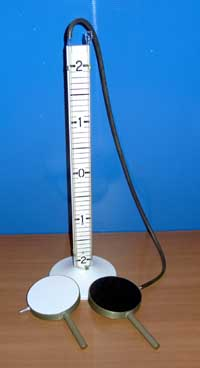
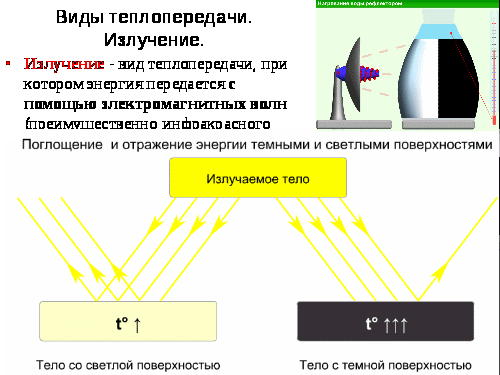
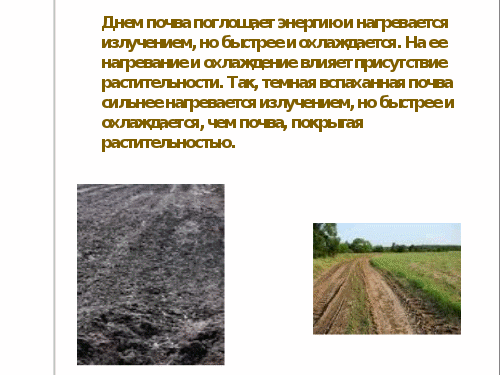
![]()
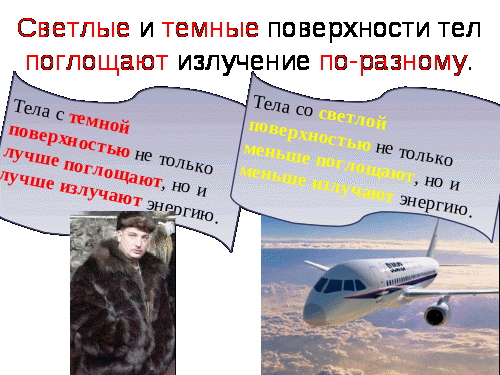
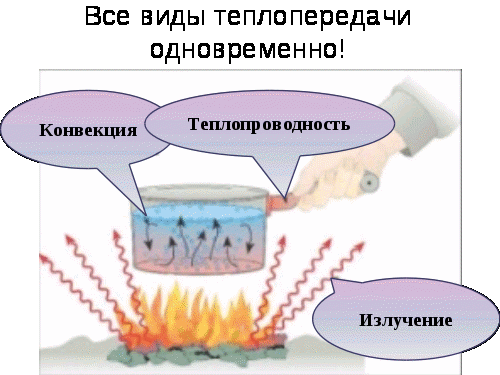
Experiment
Equipment: a heat sink, a rubber tube, a glass of water and an electric light bulb. When a dark surface is heated in a glass of water, air bubbles appear faster than when a light surface is heated.
Solve problems.
1. In a pot of water placed on an electric stove, heat transfer in water is predominantly carried out.
A. radiation and convection
b. convection and heat conduction
V. thermal conductivity
d. Convection
2. When measuring the heat capacity of a body using a calorimeter, you can get a more accurate result if the space between the two vessels of the calorimeter contains:
A) vacuum;
B) air;
B) water.
in all cases A-B measurement accuracy is the same
3. How is water heated in a kettle on an electric stove?
A. The heating of water in the kettle is carried out mainly due to the absorption of radiation from the electric stove.
b. Heating water in a kettle is carried out only due to the phenomenon of heat conduction.
V. The heating of water in the kettle occurs due to the phenomenon of heat conduction and convection.
d. The water in the kettle is heated only by convection.
4. Solid balls of the same volume heated to 1000C were lowered into identical vessels with cold water, copper into the first vessel, and zinc into the second. After reaching the state of thermal equilibrium, it turned out that different temperatures were established in the vessels. Which vessel will have the highest temperature?
A. In the first vessel, since the specific heat capacity of copper is greater than the specific heat capacity of zinc.
b. In the first vessel, since the density of copper is greater than the density of zinc.
V. In the second vessel, since the specific heat capacity of zinc is greater than the specific heat capacity of copper.
d. In the second vessel, since the density of zinc is greater than the density of copper.
5. In the room on the table are plastic and metal balls of the same
volume. Which of the balls feels colder to the touch? Explain the answer.
A. The metal ball feels colder to the touch.
b. The thermal conductivity of a metal ball is greater than that of a plastic one. The heat transfer from the finger to the metal ball is more intense, this creates a feeling of cold.
6. Religious people claim that only on Easter day the sun plays at sunrise (the disk of the sun oscillates, changes its shape and color). How to explain the apparent wobble of the disk of the rising sun?
In spring, the soil in different places is heated differently and the air above these places has a different density, a different refractive index. Air moves due to convection, light rays pass through layers of air with a changing refractive index. This causes the visible disk of the Sun to oscillate. The "play" of the Sun is observed on any day when there is a temperature, and consequently, optical inhomogeneity of the air.
And manifestations of data species V nature, technique and life. What was for...
Lesson: Grade 8 (Physics teacher Dolgova S. A.) Date Topic: Types of heat transfer
LessonBoard 2: Drawing Experience Features heat transfer View heat transfer? Which view heat transfer takes place in the measurement... Discuss examples of heat transfer in nature And technique. summarize the D/R lesson: §5-6. Report " Kinds heat transfer and their features ...
Explanatory note. This work program is compiled on the basis of an exemplary program in physics of basic general education VII
Explanatory noteKnow: - features of various methods heat transfer; - examples heat transfer V nature And technique Torch, wire, plasticine, nails... it's horizontal; d) cannot be changed. 2. What view heat transfer observed when heating the room with a battery ...
The work program in physics for the 8th grade is compiled in accordance with the federal component of the state Standard (general, secondary) education in physics,
Working programmMethods for measuring internal energy 8. Kinds heat transfer 9. Examples heat transfer V nature And technique. 10. The amount of heat. ... by radiation, the features of this kind manifestation in nature And technique studied species heat transfer comparative analysis. ...

